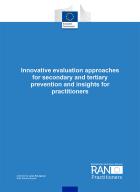Details
- Publication date
- 9 January 2024
- Author
- Directorate-General for Migration and Home Affairs
- RAN Publications Topic
- Deradicalisation/disengagement and exit work
- Evaluation
- Rehabilitation
Description
The recent years have been characterised by a serious concern, at European and global levels, related to terrorist attacks as well as to radicalisation paths promoted by extremist organisations online and offline. In the attempt to prevent and counter possible threats, governments, local communities, NGOs and private organisations have multiplied prevention interventions aimed at vulnerable subjects and towards subjects already radicalised or already involved in violent conduct (divided into numerous forms of approaches that include deradicalisation, desistance or disengagement).
Despite the proliferation of projects, policies and strategies implemented in Europe and worldwide for preventing and countering violent extremism (P/CVE), no consensus has been reached so far on what really works in the field (Marsden et al., 2017), in terms of positive results obtained, which are scientifically verifiable and sustainable. In other words, the evaluation of the implemented approaches is still in its infancy (Feddes & Gallucci, 2015; van Hemert et al., 2014).
This lack of awareness is strictly linked to some circumstances that will be considered in the present paper but that can be briefly pointed out, starting from the lack of a common definition about relevant categories (such as terrorism, radicalisation, disengagement, deradicalisation), the complexity of the involved extremist phenomena, the lack of resources invested for evaluation purposes and the difficulties to find a common aim for the evaluation process between all the different stakeholders, due to the fluidity of the concept of evaluation itself (Bellasio et al., 2018).
Starting from the very beginning of the expansion of the field of P/CVE evaluations, scholars (Feddes & Gallucci, 2015; Gielen, 2017; Lum et al., 2006; Marret et al., 2017; Nelen et al., 2010) have criticised the use of the evaluation techniques of the proposed approaches, noting that evaluation of and strategies for P/CVE advanced at different rhythms within the countries. For example, as is argued in the Global Public Policy Institute (GPPi) study (Baykal, 2021), while countries such as Canada, Finland, the Netherlands and the United Kingdom have an established tradition in evaluating P/CVE broadly, noticeable differences exist even within this group when it comes to reaching robust findings and actually implementing evaluations’ recommendations in the field.
This is particularly true for the evaluation of tertiary prevention approaches, as some authors (Hassan, Brouillette-Alarie, Ousman, Savard et al., 2021) clearly show. The interest in assessing progress in the implementation of measures and the achievement of intended results is something shared among all the involved stakeholders (Junk, 2021) as well as confirmed by the European Commission (2018).
The most obvious consequence of this two-speed system is the current limited information about scientifically oriented evaluation designs/approaches able to return objective data on what works and what does not work in the P/CVE sector. This is also true for evaluations that focus on economic efficiency and it is especially true for those focusing on efficacy (European Commission, 2018).
The present paper aims to discuss the state of the art in the field of evaluation of P/CVE strategies in secondary and tertiary prevention, in order to summarise available approaches and present obstacles and future challenges.

